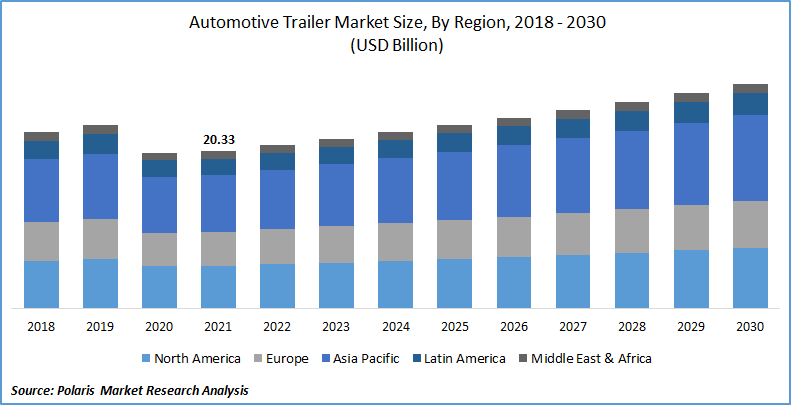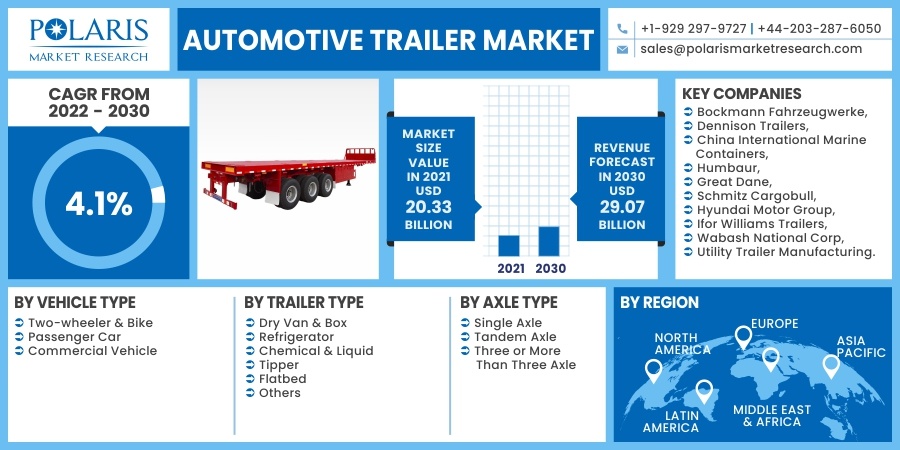
Automotive Trailer Market Share, Size, Trends, Industry Analysis Report
By Vehicle Type (Two-wheeler & Bike, Passenger Car, Commercial Vehicle); By Trailer Type; By Axle Type (Single Axle, Tandem Axle, Three or More Than Three Axle); By Region; Segment Forecast, 2022 - 2030
- Published Date:Mar-2022
- Pages: 118
- Format: PDF
- Report ID: PM2315
- Base Year: 2021
- Historical Data: 2018 - 2020
Report Outlook
The global automotive trailer market was valued at USD 20.33 billion in 2021 and is expected to grow at a CAGR of 4.1% during the forecast period. The growth of the automotive trailer market is primarily driven by the expansion of the logistics industry and the rise in cold chain transportation drop in transportation costs.

Know more about this report: request for sample pages
In addition to this, the rapid technological developments in automotive trailers and the rise in trade between countries are projected to stimulate the overall market growth at a significantly faster pace. The recent outbreak of the COVID-19 pandemic at the global level has tremendously affected the market growth due to the restriction of covid-19 protocols, along with limited international trade to manage the COVID-19 pandemic, as it is widespread at a significant level and has become a critical concern.
While, the players are also suffered disruptions in the supply chain, regulatory changes, dis-balanced working capital, and dependency on labor. Thus, the pandemic has led to a deterioration rate in the automotive trailer market growth.

Know more about this report: request for sample pages
Industry Dynamics
Growth Drivers
Since recent years, road transportation has been one of the most used modes of transportation in the logistics sector because of its better cost advantages compared to other modes. Furthermore, the rise in market demand for perishable goods, including pharmaceutical products, fresh flowers, poultry, fish, dairy products, and fruits & vegetables, has further fueled the market demand for cold chain logistics worldwide. Thus, it has strengthened the growth of the logistics sector, which eventually paved the way for the automotive trailer market worldwide.
According to the Pharmaceutical’s Commerce annual Biopharma Cold Chain Sourcebook, in 2018, 66 new drugs or new indications were endorsed by the Food and Drug Administration (FDA), of which 29 or 44% were related to cold chain drugs. This figure is rose from new FDA-approved medicines in 2017, which was estimated at only 23 cold chain drugs. As a result, the rise in the introduction of new cold chain drugs is likely to create huge market demand for cold chain logistics, further driving the market growth during the foreseen period.
Report Segmentation
The market is primarily segmented on the basis of vehicle type, trailer type, axle type, and region.
|
By Vehicle Type |
By Trailer Type |
By Axle Type |
By Region |
|
|
|
|
Know more about this report: request for sample pages
Insight by Trailer Type
The dry van & box segment is projected to gain a larger share in the global automotive market due to the surging demand for non-perishable products such as household goods, electronics, clothing, automotive parts, etc., along with the expansion of the logistics industry. The dry chain & van are completely enclosed to keep safe and secure cargo from the elements. Thus, shippers prefer this mode of automotive trailers for transporting non-perishable products, which drives the automotive segmental growth worldwide.
Further, these automotive are often secured, affordable, and versatile solutions for freight shipments (both for local and over-the-road routes). Thus, these automotive are ubiquitous, and the demand is witnessed high due to the rise in freight shipments, making the high market growth during the forecast timeframe.
Insight by Axle Type
Based on the axle type, the tandem axle segment is leading the market globally and is expected to register the fastest CAGR over the foreseen period. Tandem axles are gaining remarkable traction due to the strict government norms to curb emissions and fuel utilization that pave the way for developing efficient and lightweight vehicles.
The tandem axles are a niche product used for heavy load-bearing vehicles like automotive trailers. Therefore, the rise in focus on fuel efficiency and the growing requirement to curtail power loss have led the manufacturers to invest in such products, which is expected to contribute to high segmental growth.
Geographic Overview
Geographically, Asia Pacific is accounted for the largest revenue share. This is because Asian countries represent a promising growth of GDP, along with the robust presence of manufacturers of automotive systems and components. Further, the surging adoption of passenger cars and commercial vehicles due to rising disposable income directly impacts the higher market growth in emerging Asian countries, such as China, India, Malaysia, and others.
For instance, in 2020, the production of passenger cars in Asia-pacific was around 35.8 million, increasing from 24.6 million units since 2008, as per the International Organization of Motor Vehicle Manufacturers (OICA). The association also states that China has been the leading producer of passenger cars in the Asian region many years back, followed by Japan and India.
Europe also witnessed remarkable growth in the global market due to the largest private investors in research & development (R&D) in Europe that paved the way for the automotive trailer market. Moreover, the increasing cases of road fatalities in the United Kingdom coupled with the presence of government norms on road safety are anticipated to accelerate the demand for automotive trailers.
For instance, the Department for Transport of the UK is operated by the Secretary of State for Transport, which is accountable for road safety policy in several fields of road safety, from delivering guidance for local authorities to assessing legislations. Thus, the market will grow at an unprecedented rate throughout the forecast period.
Competitive Insight
Some of the major players operating in the global market include Bockmann Fahrzeugwerke, Dennison Trailers, China International Marine Containers, Humbaur, Great Dane, Schmitz Cargobull, Hyundai Motor Group, Ifor Williams Trailers, Wabash National Corp, and Utility Trailer Manufacturing.
Automotive Trailer Market Report Scope
|
Report Attributes |
Details |
|
Market size value in 2021 |
USD 20.33 billion |
|
Revenue forecast in 2030 |
USD 29.07 billion |
|
CAGR |
4.1% from 2022 - 2030 |
|
Base year |
2021 |
|
Historical data |
2018 - 2020 |
|
Forecast period |
2022 - 2030 |
|
Quantitative units |
Revenue in USD million and CAGR from 2022 to 2030 |
|
Segments covered |
By Vehicle Type, By Trailer Type, By Axle Type, By Region |
|
Regional scope |
North America, Europe, Asia Pacific, Latin America, Middle East & Africa |
|
Key Companies |
Bockmann Fahrzeugwerke, Dennison Trailers, China International Marine Containers, Humbaur, Great Dane, Schmitz Cargobull, Hyundai Motor Group, Ifor Williams Trailers, Wabash National Corp, and Utility Trailer Manufacturing. |
